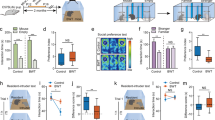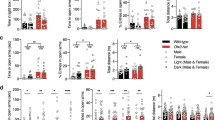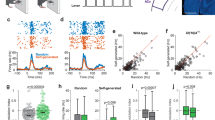Abstract
Urocortin is a member of the corticotropin-releasing hormone peptide family and is found in many discrete brain regions. The distinct expression pattern of urocortin suggests that it influences such behaviors as feeding, anxiety and auditory processing. To better define the physiological roles of urocortin, we have generated mice carrying a null mutation of the urocortin gene. Urocortin-deficient mice have normal basal feeding behavior and stress responses, but show heightened anxiety-like behaviors in the elevated plus maze and open-field tests. In addition, hearing is impaired in the mutant mice at the level of the inner ear, suggesting that urocortin is involved in the normal development of cochlear sensory-cell function. These results provide the first example of a function for any peptidergic system in hearing.
This is a preview of subscription content, access via your institution
Access options
Subscribe to this journal
Receive 12 print issues and online access
$209.00 per year
only $17.42 per issue
Buy this article
- Purchase on Springer Link
- Instant access to full article PDF
Prices may be subject to local taxes which are calculated during checkout






Similar content being viewed by others
References
Vale, W., Spiess, J., Rivier, C. & Rivier, J. Characterization of a 41-residue ovine hypothalamic peptide that stimulates secretion of corticotropin and β-endorphin. Science 213, 1394–1397 (1981).
Chadwick, D.J., Marsh, J. & Ackrill, K. Corticotropin-Releasing Factor (John Wiley, London, 1993).
Lederis, K., Letter, A., McMaster, D., Moore, G. & Schlesinger, D. Complete amino acid sequence of urotensin I, a hypotensive and corticotropin-releasing neuropeptide from Catostomus. Science 218, 162–165 (1982).
Lederis, K. et al. Urotensin I—a novel CRF-like peptide in Catostomus commersoni urophysis. Proc. West Pharmacol. Soc. 25, 223–227 (1982).
Montecucchi, P.C. & Henschen, A. Amino acid composition and sequence anaylsis of sauvagine, a new active peptide from the skin of Phyllomedusa sauvagei. Int. J. Peptide Protein Res. 18, 113–120 (1981).
Vaughan, J. et al. Urocortin, a mammalian neuropeptide related to fish urotensin I and to corticotropin-releasing factor. Nature 378, 287–292 (1995).
Reyes, T.M. et al. Urocortin II: a member of the corticotropin-releasing factor (CRF) neuropeptide family that is selectively bound by type 2 CRF receptors. Proc. Natl Acad. Sci. USA 98, 2843–2848 (2001).
Lewis, K. et al. Identification of urocortin III, an additional member of the corticotropin-releasing factor (CRF) family with high affinity for the CRF2 receptor. Proc. Natl Acad. Sci. USA 98, 7570–7575 (2001).
Hsu, S.Y. & Hsueh, A.J. Human stresscopin and stresscopin-related peptide are selective ligands for the type 2 corticotropin-releasing hormone receptor. Nature Med. 7, 605–611 (2001).
Bittencourt, J.C. et al. Urocortin expression in rat brain: evidence against a pervasive relationship of urocortin-containing projections with targets bearing type 2 CRF receptors. J. Comp. Neurol. 415, 285–312 (1999).
Spina, M. et al. Appetite-suppressing effects of urocortin, a CRF-related neuropeptide. Science 273, 1561–1564 (1996).
Kihara, N. et al. Effects of central and peripheral urocortin on fed and fasted gastroduodenal motor activity in conscious rats. Am. J. Physiol. Gastrointest. Liver Physiol. 280, G406–G419 (2001).
Moreau, J.L., Kilpatrick, G. & Jenck, F. Urocortin, a novel neuropeptide with anxiogenic-like properties. Neuroreport 8, 1697–1701 (1997).
Slawecki, C.J., Somes, C., Rivier, J.E. & Ehlers, C.L. Neurophysiological effects of intracerebroventricular administration of urocortin. Peptides 20, 211–218 (1999).
Warr, W.B. Organization of olivocochlear efferent systems in mammals. In Mammalian Auditory Pathway: Neuroanatomy Vol. 1 (ed. Webster, D.) 410–448 (Springer, New York, 1992).
Vetter, D.E. & Mugnaini, E. Distribution and dendritic features of three groups of rat olivocochlear neurons. A study with two retrograde cholera toxin tracers. Anat. Embryol. (Berl.) 185, 1–16 (1992).
Hashimoto, S., Kimura, R.S. & Takasaka, T. Computer-aided three-dimensional reconstruction of the inner hair cells and their nerve endings in the guinea pig cochlea. Acta Otolaryngol. (Stockh.) 109, 228–234 (1990).
Liberman, M. Efferent synapses in the inner hair cell area of the cat cochlea: an electron microscopic study of serial sections. Hear Res. 3, 189–204 (1980).
Vetter, D.E., Adams, J.C. & Mugnaini, E. Chemically distinct rat olivocochlear neurons. Synapse 7, 21–43 (1991).
Hoffman, D.W., Altschuler, R.A. & Fex, J. High-performance liquid chromatographic identification of enkephalin-like peptides in the cochlea. Hear. Res. 9, 71–78 (1983).
Altschuler, R.A., Fex, J., Parakkal, M.H. & Eckenstein, F. Colocalization of enkephalin-like and choline acetyltransferase-like immunoreactivities in olivocochlear neurons of the guinea pig. J. Histochem. Cytochem. 32, 839–843 (1984).
Abou-Madi, L., Pontarotti, P., Tramu, G., Cupo, A. & Eybalin, M. Coexistence of putative neuroactive substances in lateral olivocochlear neurons of rat and guinea pig. Hear Res. 30, 135–146 (1987).
Hoffman, D.W., Zamir, N., Rubio, J.A., Altschuler, R.A. & Fex, J. Proenkephalin and prodynorphin related neuropeptides in the cochlea. Hear Res. 17, 47–50 (1985).
Altschuler, R.A., Hoffman, D.W., Reeks, K.A. & Fex, J. Localization of dynorphin B-like and α-neoendorphin-like immunoreactivities in the guinea pig organ of Corti. Hear Res. 17, 249–258 (1985).
Adams, J.C., Mroz, E.A. & Sewell, W.F. A possible neurotransmitter role for CGRP in a hair-cell sensory organ. Brain Res. 419, 347–351 (1987).
Bailey, G.P. & Sewell, W.F. Calcitonin gene-related peptide suppresses hair cell responses to mechanical stimulation in the Xenopus lateral line organ. J. Neurosci. 20, 5163–5169 (2000).
Sewell, W.F. & Starr, P.A. Effects of calcitonin gene-related peptide and efferent nerve stimulation on afferent transmission in the lateral line organ. J. Neurophysiol. 65, 1158–1169 (1991).
Spina, M.G. et al. Time-dependent induction of anxiogenic-like effects after central infusion of urocortin or corticotropin-releasing factor in the rat. Psychopharmacology (Berl.) 160, 113–121 (2002).
Smith, G.W. et al. Corticotropin repleasing factor receptor–1 deficient mice display decreased anxiety, impaired stress response and aberrant neuroendocrine development. Neuron 20, 1093–1102 (1998).
Timpl, P. et al. Impaired stress response and reduced anxiety in mice lacking a functional corticotropin-releasing hormone receptor 1. Nature Genet. 19, 162–166 (1998).
Bale, T.L. et al. Mice deficient for corticotropin-releasing hormone receptor-2 display anxiety-like behavior and are hypersensitive to stress. Nature Genet. 24, 410–414 (2000).
Coste, S.C. et al. Abnormal adaptations to stress and impaired cardiovascular function in mice lacking corticotropin-releasing hormone receptor-2. Nature Genet. 24, 403–409 (2000).
Kishimoto, T. et al. Deletion of u.c.rhr2 reveals an anxiolytic role for corticotropin- releasing hormone receptor-2. Nature Genet. 24, 415–419 (2000).
Ruggero, M.A., Robles, L., Rich, N.C. & Recio, A. Basilar membrane responses to two-tone and broadband stimuli. Phil. Trans. R. Soc. Lond. B 336, 307–314 (1992).
Ruggero, M.A. Responses to sound of the basilar membrane of the mammalian cochlea. Curr. Opin. Neurobiol. 2, 449–456 (1992).
Probst, R., Lonsbury-Martin, B.L. & Martin, G.K. A review of otoacoustic emissions. J. Acoust. Soc. Am. 89, 2027–2067 (1991).
Turnbull, A.V., Vaughan, J., Rivier, J.E., Vale, W.W. & Rivier, C. Urocortin is not a significant regulator of intermittent electrofootshock-induced adrenocorticotropin secretion in the intact male rat. Endocrinology 140, 71–78 (1999).
Smagin, G.N., Howen, L.A., Ryan, D.H., DeSouza, E.B. & Harris, R.B. The role of CRF2 receptors in corticotropin-releasing factor and urocortin-induced anorexia. Neuroreport 9, 1601–1606 (1998).
Kozicz, T., Yanaihara, H. & Arimura, A. Distribution of urocortin-like immunoreactivity in the central nervous system of the rat. J. Comp. Neurol. 391, 1–10 (1998).
Skelton, K.H., Nemeroff, C.B., Knight, D.L. & Owens, M.J. Chronic administration of the triazolobenzodiazepine alprazolam produces opposite effects on corticotropin-releasing factor and urocortin neuronal systems. J. Neurosci. 20, 1240–1248 (2000).
Eybalin, M. Neurotransmitters and neuromodulators of the mammalian cochlea. Physiol. Rev. 73, 309–373 (1993).
Walsh, E., McGee, J., McFadden, S. & Liberman, M. Long-term effects of sectioning the olivocochlear bundle in neonatal cats. J. Neurosci. 18, 3859–3869 (1998).
Vetter, D.E. et al. Role of α9 nicotinic ACh receptor subunits in the development and function of cochlear efferent innervation. Neuron 23, 93–103 (1999).
Elgoyhen, A.B., Johnson, D.S., Boulter, J., Vetter, D.E. & Heinemann, S. α9: an acetylcholine receptor with novel pharmacological properties expressed in rat cochlear hair cells. Cell 79, 705–715 (1994).
Acknowledgements
We thank P. Sawchenko for bringing to our attention the potential role of Ucn on the auditory system. We also thank P. Chen for help with the image analysis, K. Creehan for animal assistance and S. Guerra and M. Arends for editorial assistance. This work was supported in part by grants from the US National Institutes of Health (to S.F.H., M.C.L., W.V. and K.F.L.), the Robert J. and Helen C. Kleberg Foundation, the Ludwick Family Foundation and the Foundation for Research. C.L. and L.Z. were supported by NIH National Research Service Award fellowships. This is publication number 14789-NP from The Scripps Research Institute. K.-F.L. is a Pew Scholar.
Author information
Authors and Affiliations
Corresponding author
Ethics declarations
Competing interests
The authors declare no competing financial interests.
Rights and permissions
About this article
Cite this article
Vetter, D., Li, C., Zhao, L. et al. Urocortin-deficient mice show hearing impairment and increased anxiety-like behavior. Nat Genet 31, 363–369 (2002). https://doi.org/10.1038/ng914
Received:
Accepted:
Published:
Issue Date:
DOI: https://doi.org/10.1038/ng914
This article is cited by
-
TBX2 specifies and maintains inner hair and supporting cell fate in the Organ of Corti
Nature Communications (2022)
-
Urocortins in the mammalian endocrine system
Acta Veterinaria Scandinavica (2019)
-
The adhesion molecule cadherin 11 is essential for acquisition of normal hearing ability through middle ear development in the mouse
Laboratory Investigation (2018)
-
Control of chronic excessive alcohol drinking by genetic manipulation of the Edinger–Westphal nucleus urocortin-1 neuropeptide system
Translational Psychiatry (2017)
-
The Mammalian Olivocochlear System—A Legacy of Non-cerebellar Research in the Mugnaini Lab
The Cerebellum (2015)



